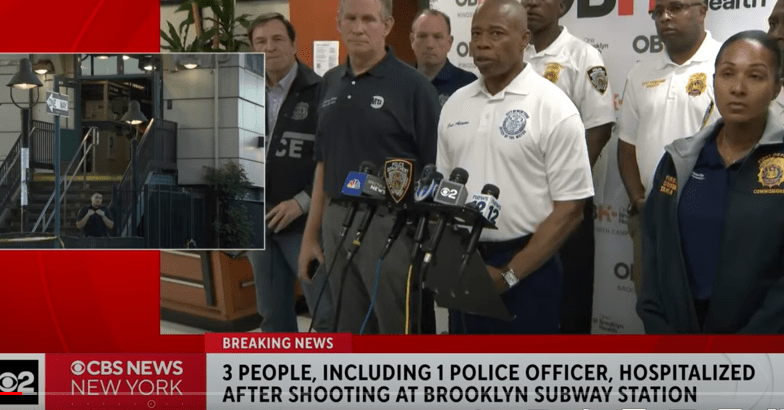|
Getting your Trinity Audio player ready...
|
Rising Violent Crime in Manhattan’s Tourist Hub Amid Citywide Trends: A Closer Look
Edited by: TJVNews.com
As Mayor Eric Adams prepares to deliver his State of the City address, highlighting improvements in crime reduction across New York City’s five boroughs, a growing surge of violent crime in one of Manhattan’s most iconic areas casts a shadow over these optimistic figures. According to a report in The New York Post, the contrast between Manhattan’s North Precinct, which encompasses tourist-heavy landmarks like Radio City Music Hall, Rockefeller Plaza, the Theater District, and St. Patrick’s Cathedral, and the broader citywide crime statistics is stark, highlighting both the complexity of New York’s ongoing crime challenges and the nuanced reality of public safety.
According to New York Police Department (NYPD) data as of September 8, violent crime in Manhattan’s North Precinct has risen dramatically compared to the same period in 2023. As per the information provided in The Post report, robberies have surged by more than 90%, while felony assaults have skyrocketed by nearly 73%, underscoring a sharp increase in the kind of crimes that can most directly impact both residents and the millions of tourists who frequent the area.
In addition to these worrying trends, burglaries in the precinct have increased by 58%, while reports of murders and rapes have both risen. Three homicides have been reported in the precinct so far this year, one more than last year, while rape cases have increased from seven to nine, The Post report said. These numbers paint a grim picture of escalating crime in an area that should serve as a beacon of safety for both locals and visitors alike.
Security professionals stationed in the area echo the sentiment of growing unease. One security guard working near Eighth Avenue and West 47th Street shared their daily challenges with The Post, highlighting the increasing prevalence of drug activity and homelessness as ongoing concerns. “Society is a mess, and all we can do is pray,” the guard remarked.
Locals, too, have expressed frustration. Vagrants and individuals affected by homelessness have become an increasingly visible issue, often blocking building entrances and creating disturbances for residents. As one local put it, the situation requires constant vigilance and intervention. “We don’t let them stay, so we have to tell them to leave. That’s why [security] are here,” the resident noted when speaking with The Post, emphasizing the pressure on both private citizens and security personnel to maintain order.
The sharp rise in violent crime in the Manhattan North Precinct stands in stark contrast to the citywide crime statistics, which paint a far more optimistic picture of public safety under Mayor Adams’ administration. Across the five boroughs, overall crime has fallen by 2.5% for the same period, with a particularly notable decline in murders, down nearly 13%. The Post report also indicated that burglaries citywide have also decreased by nearly 9%, further contributing to the Mayor’s message that New York is making strides in public safety.
These citywide figures are expected to be a cornerstone of Mayor Adams’ upcoming State of the City address, where he is likely to highlight the city’s progress in reducing crime. The information contained in The Post report said that the Mayor has made public safety a central focus of his administration, building on his reputation as a former NYPD officer and positioning himself as a strong advocate for both law enforcement and criminal justice reform.
However, the troubling spikes in crime in one of Manhattan’s busiest precincts highlight the disconnect between broad citywide trends and the reality on the ground in some neighborhoods. For locals and businesses in the tourist-heavy areas of Midtown Manhattan, the statistics tell a different story, one of an escalating crime problem that threatens the safety and stability of one of the city’s most important economic and cultural hubs.
While the situation in the Manhattan North Precinct is undoubtedly challenging, some local residents remain cautiously optimistic. Ojo, a 55-year-old resident, noted that while problems persist, they tend to come in waves. “This is a beautiful block,” Ojo told The Post. “The problems come in waves, and when they do, we bring attention to it, and it gets fixed.”
Despite these efforts, many fear that without sustained attention from city leadership, the crime problem in Manhattan’s tourist hub could worsen. The area’s economic dependence on tourism makes it particularly vulnerable to fluctuations in crime, as rising disorder and violence may deter visitors and harm businesses. In a city that prides itself on resilience and recovery, maintaining a sense of safety in high-profile areas is crucial to ensuring long-term prosperity.
A spokesperson for Mayor Adams called attention to the administration’s commitment to public safety, telling The Post that “Public safety and justice are the prerequisites to prosperity.” From the outset of his term, Mayor Adams has emphasized a tough-on-crime approach, combined with policies that aim to bring justice to all New Yorkers. The administration has removed over 18,000 illegal guns from the streets, a critical step in reducing gun-related violence and ensuring that communities are safer.
The progress, particularly in reducing shootings, has been noteworthy. In August, shootings hit a record low for the month, a promising indicator of the administration’s focus on curbing gun violence. The Post report also indicated that subway robberies, once a major concern for commuters and tourists, have also plummeted to their lowest levels in recorded history. Moreover, the city has enjoyed eight consecutive months of overall crime decline, reflecting a broader trend of improvement.
The NYPD’s role in these achievements is pivotal. Filled with what Mayor Adams calls “dedicated public servants,” the department has consistently adapted its strategies to tackle emerging crime trends. Officers continue to patrol the streets and subway systems, ensuring that public safety remains a priority even as the city faces new challenges.
Many residents and business owners in the Manhattan North Precinct have observed a noticeable improvement in safety over recent years, despite the concerning crime figures for 2024 so far. Adam Richardson, a local resident, emphasized that while problems remain, the situation has improved significantly since the height of the COVID-19 pandemic. “It’s certainly safer than COVID times,” he said , while speaking to The Post. Richardson pointed out that drug-related issues, which were once pervasive, have been reduced, particularly the alarming presence of discarded syringes on the streets. “A lot, lot less syringes. That used to be a real problem,” he told The Post, drawing attention to how these visible signs of urban decay have subsided.
Sal Baker, another Manhattan resident, echoed these sentiments, recalling the conditions just a year ago. “Much better than a year ago. Much, much better,” Baker said, as he spoke with The Post. He highlighted the reduction of drug paraphernalia, such as needles and capsules containing fentanyl, which posed a serious danger to pedestrians, especially dog owners. “It was awful last year,” Baker recalled to The Post. “There used to be needles everywhere.” This progress has contributed to a greater sense of safety and order in the community, offering a glimpse of hope that efforts to tackle crime are having a tangible impact.
However, while improvements on the streets are evident, the story below ground in the city’s vast subway system remains a more troubling one.
Despite the decline in overall transit crime, a disturbing trend has emerged in New York City’s subway system: the murder rate has soared by 60% this year. According to NYPD statistics, eight people have been killed in the subway system so far in 2024, compared to five murders during the same period in 2023. This uptick in subway-related homicides is alarming, especially when viewed against historical data. As per the information contained in The Post report, from 1997 to 2020, the subway system never saw more than five murders in a single year. The current rate represents a significant departure from that trend and raises concerns about passenger safety.
Although crime across the subway system has decreased overall, these fatal incidents cast a dark shadow over the positive progress elsewhere. The increase in subway murders poses a complex challenge for city officials and law enforcement, as the underground transit system is the lifeblood of New York, carrying millions of passengers every day. The Post report noted that the psychological impact of these killings is profound, creating an environment of fear and uncertainty even as other crimes in the system, such as robberies, have seen historic reductions.
The challenge for the NYPD and city leaders lies in addressing this specific form of violence without overshadowing the broader gains made in crime reduction across the transit system. For many New Yorkers, the perception of safety in the subway is crucial, and while the overall data may show improvements, the rise in murders has heightened anxiety for commuters.
According to NYPD data, the neighborhood encompassing the Manhattan North precinct has seen a shocking 90.4% increase in robberies compared to the same period in 2023. So far this year, there have been 158 robberies in the precinct, up from just 83 last year. Robberies are particularly concerning as they typically involve violence or the threat of violence, creating an atmosphere of fear for both locals and the influx of visitors who frequent the area.
These troubling crime statistics are in stark contrast to some other parts of the city. For example, Midtown South, which covers nearby areas including Penn Station, Madison Square Garden, and Greeley Square, has seen an overall drop in crime by more than 10% this year, as was reported by The Post. Despite this improvement, even Midtown South has not been immune to rising violent crime, with four murders reported so far this year—double the number from the same period last year—and a doubling of rape cases from 10 to 20.
One particularly notorious stretch of Midtown South has drawn significant attention for its bleak conditions. Dubbed the “Strip of Despair,” this block along Eighth Avenue has become a symbol of the city’s struggle with homelessness, drug addiction, and mental health crises. The report in The Post explained that merchants and residents alike describe an environment plagued by open-air drug use, emotionally disturbed vagrants, and rampant shoplifting, creating a sense of chaos and lawlessness that threatens the fabric of the community.
“It’s like we’ve been bombed,” one resident told The Post, reflecting on the rapid decline of the area. “You see money exchanging, you see the crack pipes being lit, you see people fighting. You don’t want to dare get stuck in the middle of that.” This description paints a grim picture of a neighborhood in freefall, where daily life is dominated by disorder and fear.
For business owners, the “Strip of Despair” has become a battleground where maintaining a sense of normalcy feels increasingly impossible. With drug deals taking place in plain sight and brazen shoplifters walking into stores without fear of repercussions, many merchants feel abandoned by city leadership. Some argue that the visible decay along Eighth Avenue is emblematic of a larger problem—one that will require more than policing to solve.





